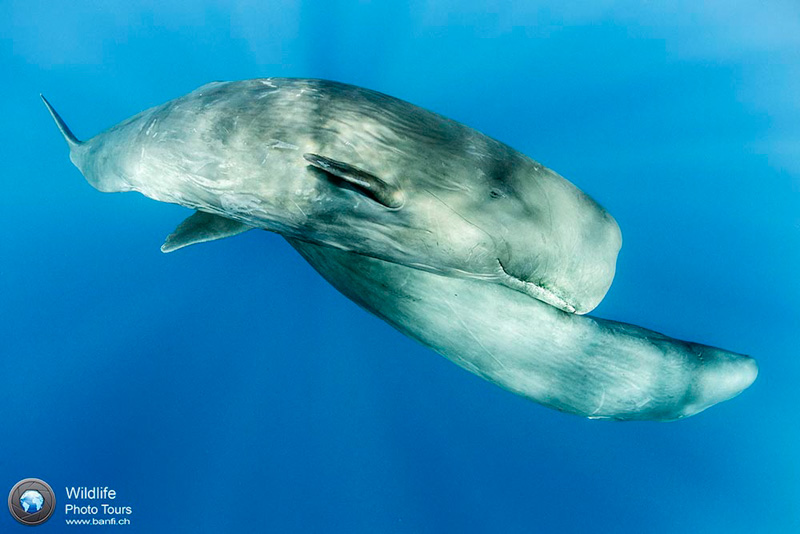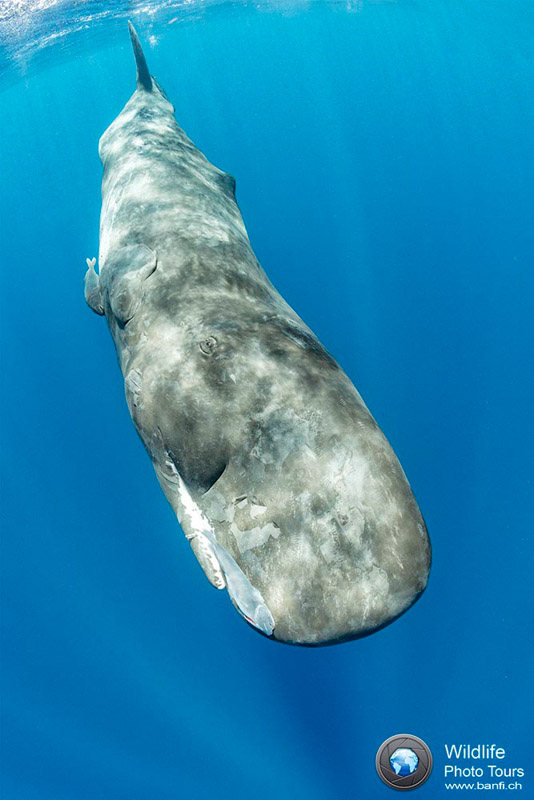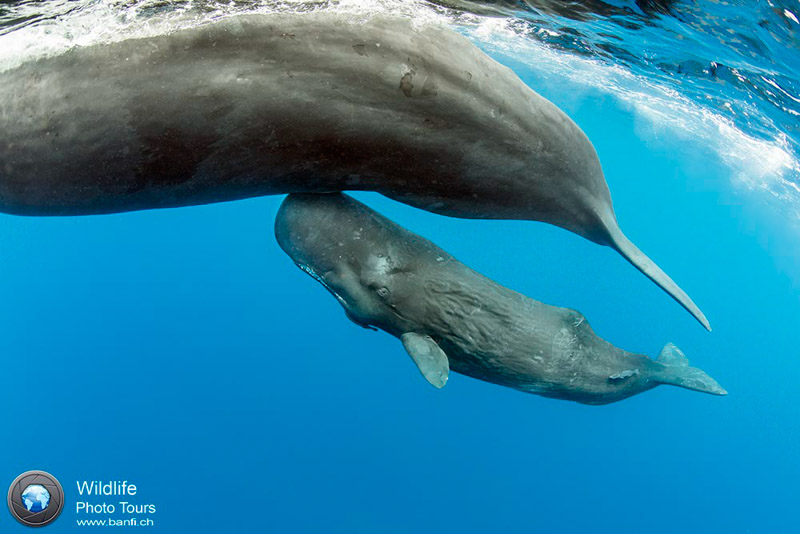Sperm Whale Photography with Franco Banfi
A note from the Editor: I met Franco Banfi on an iceberg diving trip in East Greenland. It’s not often I get to sit down and talk with a professional underwater photographer, and it was a lot of fun. Franco was really open about sharing his experiences and amazing photos from freediving with sperm whales, so I pulled out my smartphone and recorded our kitchen table conversation. I really enjoyed everything he shared, especially about sperm whale behaviors, and I hope you do too! – Bryan Chu (Associate Editor)

Bryan: How long have you been diving for?
Franco: A long time…thirty, maybe thirty five years.
Bryan: What got you into underwater photography?
Franco: The first place I went diving was the Maldives, and I started taking photos there with a Nikonos.
Bryan: How long have you been doing whale photography for?
Franco: Let’s say for the last 5-6 years (more intensely)
Bryan: Do you have a favourite whale to photograph?
Franco: I have photographed sperm whales, blue whales, killer whales, bryde whales, humpbacks. I don’t have a favorite. I like all whales!
Bryan: You have done a lot of sperm whale photography. What do you like about photographing them in particular?
Franco: I mostly like big animals. When I started doing underwater photography everything was good, but now I am more focused on big things, including whales. I like to photograph and see things that not everybody sees. It’s also interesting because with whales you’re not diving, but swimming or free-diving. So along with photography skills, you also need to have free-diving and swimming skills. It’s very nice…once you start doing it you can understand. If you swim close to an animal like this, you have a chance the look them in the eyes, to see this animal that looks at you. You start to appreciate and want to do more.

Bryan: What are your favourite behaviours to observe with sperm whales?
Franco: Every time you have an encounter with sperm whales or other whales, if you observe carefully, then sometimes you’ll understand what the whale is doing. You can see that the whale is looking at you, and the whale’s behavior in some ways is according to what you are doing.
I can share an example. One time I jumped in the water and there were two whales together. When I jumped in the water the two separated. One went right, one went left. So I decided to follow the one on the left. As a photographer you always want to be in front of the whale, because if not you just photograph the tail. So I tried to go beside the whale and was able to get alongside. This doesn’t mean that I was a good swimmer – it means that the whale went slow enough to allow me to come up alongside of it. The whale was watching me. When she saw me, she started to swim a little bit faster. I sped up some more and got alongside the whale again. The whale watched me, and started to go faster again.
I think this whale was almost thinking that I was the other whale, that we were together and she was in some way waiting for me. It’s like she was saying “come on, go faster.” Because she was not escaping, but just staying a little bit ahead. This is something that you can experience when you watch and pay attention to what happens. Sperm whales are mammals with a brain…a really big brain.

Bryan: Where do you go for encountering sperm whales?
Franco: I go to the island of Dominica in the Caribbean, because there are some resident sperm whales there. So you have excellent possibilities to encounter them. Other locations you can see sperm whales include the Azores in the Atlantic, and in the North of Sri Lanka, as well as in other places. But the ones in Dominica are probably the best to approach because they stay in the area and they have seen divers. Of course to go in the water with the whales you need special permission. It’s not something that everyone can do as they don’t give permission to everybody. What I have heard is that they give 8 permits per year. These permits do not overlap, so if you have your permit you have your time, and the next group will go after. There are never several boats following one whale, like in other places.
Bryan: Have you ever felt nervous or had any close encounters?
Franco: With whales? No. I must tell you, my feeling, my idea is if I am afraid of something I don’t do it. If I want to do something, I don’t care, I do it. If not, I stay out of the water.
Bryan: How can I tell when I see a sperm whale in the distance?
Franco: For people that don’t know sperm whales, there’s only one blowhole on the left, and it goes at 45 degree.
Bryan: How big are these animals you are diving with?
Franco: The larger ones are an average of 10-12 meters long. Big males can be 18 m but I have never seen one that large. The ones I see mostly are around 10-12. The babies are maybe 4 m. For comparison, humpbacks are around 14-15 m long.

Bryan: Do you get to observe them using their sonar? Is it loud?
Franco: Yes. Sometimes they look at you and open their mouth; that’s because they are scanning you. They open their mouth because they use their jaw as an amplifier for sonar. Even if you don’t hear it, they are scanning you.
Their sonar goes out at 45 degrees from the top of their head. If they want to use sonar at the surface, it would just go up and out of the water. So, sometimes they will swim upside down at the surface, which lets them use their sonar there.
They can be very loud. There’s a buoy a few km from the island where they have a piece of net connected, for fishing. Sometimes we stop there to have a swim. One time I found a sperm whale there; we jumped in the water and could hear the sonar. It was funny because this guy was trying to find out what this was. You could see he was doing a lot of clicking and scanning. Probably he was wondering what this thing in the middle of the ocean was. He was a young guy.

Bryan: What kind of gear and settings do you use to photograph sperm whales? And how about lighting?
Franco: I use a Canon 5D Mark IV in an Isotta housing, with an 8-15mm fisheye lens. Normally I use Seacam strobes, but for sperm whales I use ambient light. (Editor’s note: check out our review of the Canon 5D Mark IV).
For settings I tend to use between 300 and 600 ISO, and around f/8 or f/11. I try to keep the shutter speed around 1/250 sec and focus on maintaining this rather than the f-stop. If I am shooting down then I sometimes need to go up to about ISO 1250.
I use autofocus, which picks up on the skin so I don’t tend to have focus issue. Shooting without a strobe you try to be in there with the sun at your back. Of course, sometimes you jump in the water and everything is perfect, but the sun is behind the whale. Well, you still have to shoot!
Bryan: How many people do you take on your tours? And do you use any specialized gear?
Franco: Small groups; 4-5, maximum of 6 people on the boat. We use long freediver fins. We also tried using a monofin, but it was no good with the whales. (Editor’s note: monofins are the most efficient freediving fin but greatly reduce your maneuverability when compared to dual fins).

Bryan: How do things work with getting in the water with the whales?
The boat captain tries to get you in the water in front, so they swim by and you are in the middle of them. Sometimes they stop and socialize. For us as photographers, this is the best! Here, when they socialize, you get many in the picture. They grab each other and play around.
Bryan: How long will they do that for?
Franco: It depends. They can do it for 10 seconds or a few minutes. It also depends what you do yourself. If you see something like this you try not to disturb it too much, because if you go in the middle then it will go away.

Bryan: Do you ever see sperm whales in a vertical position?
Franco: Yes. They just found out not many years ago that sperm whales stop, go into vertical position and sleep for 10-15 minutes. They sleep for short stretches many times a day, but they are not sleeping for 2 hours at a time or anything like that.

Franco: This is when they are sleeping. These are the adults, and these are the young. They keep the young in the middle for protection. This was last year and we saw it two times. But in the past 5 years we probably saw it another two times. It probably depends how much we press them. The more you leave them quiet, the more they probably go to sleep.
Bryan: How about when the calves are feeding? Are they stationary?
Franco: When the calf is eating, they don’t stop. When the calf wants to eat he goes across to his mother and tries to get some milk. But they don’t stop. Pods of sperm whales are made up mostly of females. Males don’t live with the group. They are adults after 10-12 years, at which point they leave the group and only come back when they want to mate.
You see the mother has a bump on her underside. The calf puts his head by that bump when they’re swimming. Because doing this, it has less effort. This calf is maybe a few months old. So if it’s doing this, it can go faster. Now it’s not exactly in the right position

Bryan: Cool, that’s a lot of neat information about sperm whales. Thank you so much for sharing your awesome photos and great stories! How can people find out more about sperm whale photography?
Franco: No problem. They can email me at tour@banfi.ch. I also have a webpage which will soon be ready: www.wildlifephototours.ch.
Join us for an Upcoming Whale-focused UWPG Photo Workshop
Additional Reading
- Canon 5D Mark IV Camera Review
- Canon EF 8-15mm F/4 Fisheye Lens Review
- Capture Great Photos in Blue Water
- Freediving Photography with the Olympus TG-5
- Ambient Light Shooting and White Balance
RECOMMENDED ARTICLES
SUPPORT THE UNDERWATER PHOTOGRAPHY GUIDE:
The Best Service & Prices on u/w Photo Gear
 Visit Bluewater Photo & Video for all your underwater photography and video gear. Click, or call the team at (310) 633-5052 for expert advice!
Visit Bluewater Photo & Video for all your underwater photography and video gear. Click, or call the team at (310) 633-5052 for expert advice!
The Best Pricing, Service & Expert Advice to Book your Dive Trips
 Bluewater Travel is your full-service scuba travel agency. Let our expert advisers plan and book your next dive vacation. Run by divers, for divers.
Bluewater Travel is your full-service scuba travel agency. Let our expert advisers plan and book your next dive vacation. Run by divers, for divers.






























